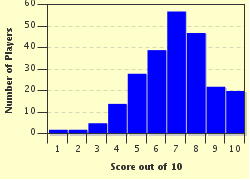Quiz Answer Key and Fun Facts
1. Richard Hollingshead is credited with developing the first drive-in theater, which opened June 6, 1933. In what eastern U.S. state was it located?
2. What was the first film shown at Hollingshead's drive-in, and therefore the first film shown at any drive-in theater?
3. What 1941 innovation by RCA solved one of the major problems of early drive-ins?
4. In 2010, the world's largest drive-in theater was in Florida. What other major activity, also billed as the world's largest, was taking place on that site?
5. Growth of attendance at drive-in theaters in the U.S. slowed substantially during World War II. Which of the following was not a significant reason for this slowing?
6. What is a popular descriptive phrase used for drive-in theaters by people talking about the theaters' reputation for "intimate romantic activity"?
7. Some moviegoers avoided paying the "per person" entry fee at drive-ins by hiding in the cars' trunks.
8. In the late 1960s and the 1970s, attendance at drive-ins was stagnant. What is the particular film "genre" that is said to have either helped cause this lack of growth or arose in part because of it?
9. In which of the following countries did drive-in theaters not find early and enthusiastic acceptance?
10. The popularity of the drive-in theater went dramatically bust in the 1980s. Which of the following is not usually listed as one of the principal reasons for its rapid decline?
Source: Author
ArlingtonVA
This quiz was reviewed by FunTrivia editor
kyleisalive before going online.
Any errors found in FunTrivia content are routinely corrected through our feedback system.

